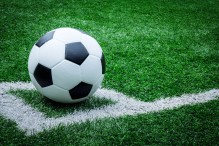If your feet are bothering you it becomes hard to play comfortably, sometimes it gets hard to play at all! Your foot problems can really add up and dealing with breaking in a new pair of cleats can cause injuries, such as cramping, blistering, calluses, plantar fasciitis and minor cases of turf toe.
Here are Six Tips To Keep Your Feet Healthy.
1. Get the right fit!
Believe it or not if you wear cleats that are too small for a long period of time you can change the structure of your feet, and not in a good way. It can lead to issues like hammer toe and can increase the likely hood of getting turf toe which can drastically impact performance and day to day comfort. If it is flush with your big toe and/or squeezing against your little toe it is too tight, go up a half size at least. It is equally important to get the right width as well to avoid cramping and arch discomfort. Though for some foot types insoles will be a must-have.
2. Trim your nails, shave down over-sized calluses/bunions
Nothing sucks more than ripping up a toenail and you guys don’t need me to tell you that. It isn’t unusual to end up on the receiving end of a rough challenge and end up getting your toes stepped on so it is possible to crack a toenail and the longer they are the easier they are to damage. But another part of making sure your nails are trimmed and your calluses or bunions shaved down is important for getting a proper and comfortable fit. Blood blisters can form under a callus if it gets to be too big. I’ve had this experience myself and it sucks.
3. Care for the muscles in your foreleg
A lot of foot issues can be potentially be caused by tightness in the foreleg. You also want to be able to avoid getting shin splints or a torn Achilles so self-care for these muscles are a must. Useful foreleg stretches will help reduce shin splints and possible Achilles tears.
4. Foot care techniques
These following foot care techniques will be good for plantar fasciitis, foot discomfort, foot cramping or tightness. However before doing any of them make sure there are no breaks or tears in the muscles of your foot if there is a suspected injury. These techniques should be practiced at least once every other day for any benefit. I usually do them twice a day on a game day.
- Take a pressurized can of spray, it can be shaving cream can or deodorant, step on it and roll it under foot and stop on the sore spots. Make sure to put some pressure on it otherwise you won’t get the benefit. It will hurt at first but the more you do it the less it will hurt. If you are feeling adventurous do it with a pair of golf balls.
- Soak your feet in ice water for 3-5 minutes. Don’t want to do it too long to avoid getting frostbite. This will reduce swelling and inflammation.
- Barefoot exercises will get the muscles in the leg and foot to strengthen. Barefoot shoes can run anywhere from $70 to $100 for a decent pair. I prefer minimalist shoes with a very small heel rise. It is best to start off barefoot running very carefully as to not cause foot injuries so it is best to work your way up.
- Double socking can really add a new degree of comfort and can supply a snug fit to most shoes. It also decreases the likelihood of blistering. Many times wearing two socks can make a world of difference. I also find that it doesn’t really effect ball feel noticeable so it isn’t going to harm your game any.


